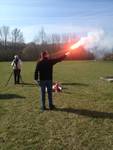Crew training
Our program includes:
CRM - Initial
CRM - Initial (AMC1 ORO.FC.115&215)
The abbreviation stands for CRM Crew Resource Management. This means the optimal and sensible use and management of all technical means available to the crew as well as human skills.
- Training Content:
Human misconduct / error chain / detection and avoidance
of mistakes
Safety culture in the company / standardized operating procedures (SOP)
Stress, stress processing / fatigue and attention
Situation awareness / information acquisition and processing / managing
the workload
decision making
Communication / coordination inside and outside the cockpit
Leadership / Assertiveness / Synergy (knowledge multiplication)
Automation and philosophy of use
Type specific differences
case studies
Aviation safety and accident prevention
- user group
This training is specialized at flight crew members
CRM - Recurrent
CRM - Recurrent (AMC1 ORO.FC.115&215)
he CRM training is valid for one year. All important topics are discussed within a period of at most 3 years.
- Training content:
repeats and deepening of set
CRM Basic Training Topics (Initial)
Coordination / communication
Accident analyzes via reports and videos
- User group:
This training is specialized at flight crew members
Dangerous Goods
Safe Transport of Dangerous Goods by Air
Definition of dangerous goods:
These are objects or substances that represent a significant risk for health and safety to air transportation. This is described in Section 3 of the IATA Dangerous Goods Regulation (DGR).
- Training content:
General philosophy (e.g. base regulations, definitions, sensitization)
Restriction (e.g. prohibited items, restricted use)
List of Dangerous goods
Marking and labeling
Storage and load procedures
Deployment of information
- Selected peaple:
This training is aimed at pilots, post holder and ground staff.
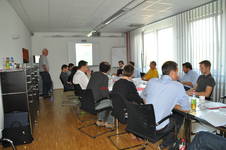
Emergency and Safety Equipment Training
Every crew member has emergency training once a year
to be completed.
- Training content:
Use of life jackets and life rafts
Use of oxygen masks
Use of fire extinguishers
Instructions regarding the storage and use of all safety and emergency equipment carried on an aircraft.
- Selected people:
This training is aimed at pilots, post holder and ground staff.
Fire Fighting
Fire fighting with fire extinguishers must also be trained regularly in practice.
Our fire fighting training includes a theoretical and a practical part.
- Content of theoretical part:
Fire protection and escape route signs
Burning and extinguishing, fire classes, extinguishing substance
Small extinguishers, fire extinguishers
Use of fire extinguishers, correct use of fire extinguishers - Content of praczticle part:
Practical training with fire extinguishers out- and indoors on small fire sources
- Selected persons:
This training is aimed at pilots, post holder and ground staff.
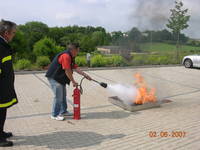
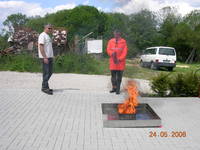
First Aid
All crew members should attend first aid training periodical times. Our courses for fast life-saving activities are carried out by a qualified doctor or paramedic.
- Training content:
Hypoxia
Stress reactions
Allergic reaction
Hyperventilation
Gastrointestinal disorders
Epilepsy, heart attack, diabetes
State of shock
Burns, wounds, broken bones
- Selected people:
This training is aimed at pilots, post holder and ground staff.
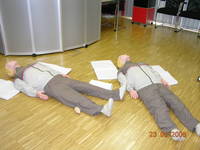
Sea Survival Training
The "Survival at Sea" training is intended to help with theoretical and, above all, practical training to increase the probability of surviving ditching by plane or helicopter.
Theoretical instruction in the dangers of cold water, in the existing rescue equipment (life jacket, life raft, survival suits etc.), in pyrotechnic emergency signals and in the rescue and recovery options of the search and rescue service (SAR).
Practical handling of pyrotechnic emergency signals.
Practical survival training in the water: handling life jackets and life rafts; Group behavior in water
- Selected persons:
This training is aimed at cockpit crews as well as cabin crews who have to travel long distances over water (offshore mechanics; ferry pilots, flight attendants, etc.)

